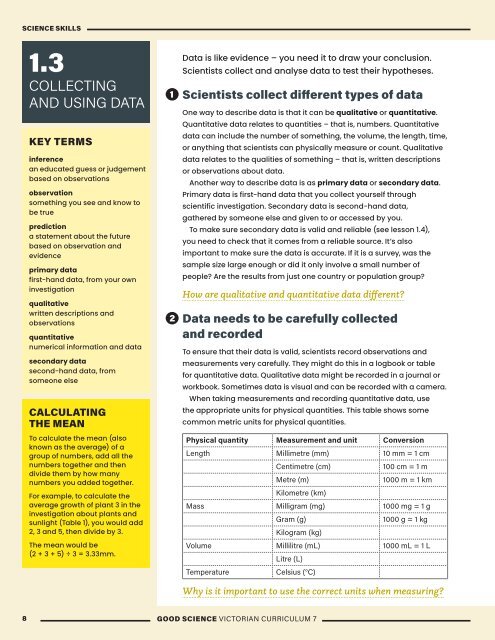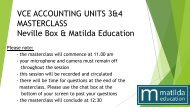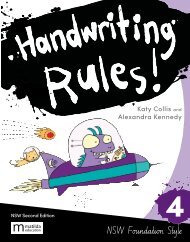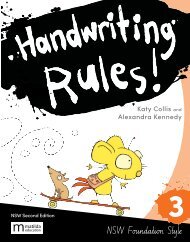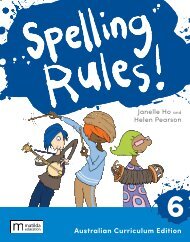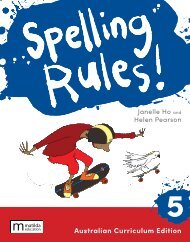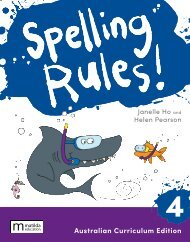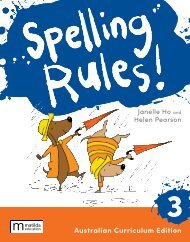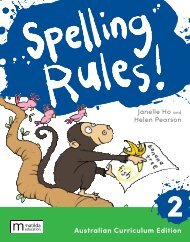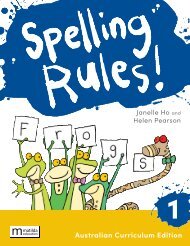Good Science Victorian Curriculum Year 7
Digital sample of Matilda's newest publication, Good Science Victorian Curriculum Year, authored by Emma Craven and Aaron Elias. For more information visit www.matildaeducation.com.au or email Katrina Tucker, katrinatucker@matildaed.com.au
Digital sample of Matilda's newest publication, Good Science Victorian Curriculum Year, authored by Emma Craven and Aaron Elias. For more information visit www.matildaeducation.com.au or email Katrina Tucker, katrinatucker@matildaed.com.au
Create successful ePaper yourself
Turn your PDF publications into a flip-book with our unique Google optimized e-Paper software.
SCIENCE SKILLS<br />
1.3<br />
COLLECTING<br />
AND USING DATA<br />
KEY TERMS<br />
inference<br />
an educated guess or judgement<br />
based on observations<br />
observation<br />
something you see and know to<br />
be true<br />
prediction<br />
a statement about the future<br />
based on observation and<br />
evidence<br />
primary data<br />
first-hand data, from your own<br />
investigation<br />
qualitative<br />
written descriptions and<br />
observations<br />
quantitative<br />
numerical information and data<br />
secondary data<br />
second-hand data, from<br />
someone else<br />
CALCULATING<br />
THE MEAN<br />
To calculate the mean (also<br />
known as the average) of a<br />
group of numbers, add all the<br />
numbers together and then<br />
divide them by how many<br />
numbers you added together.<br />
For example, to calculate the<br />
average growth of plant 3 in the<br />
investigation about plants and<br />
sunlight (Table 1), you would add<br />
2, 3 and 5, then divide by 3.<br />
The mean would be<br />
(2 + 3 + 5) ÷ 3 = 3.33mm.<br />
1<br />
2<br />
Data is like evidence – you need it to draw your conclusion.<br />
Scientists collect and analyse data to test their hypotheses.<br />
Scientists collect different types of data<br />
One way to describe data is that it can be qualitative or quantitative.<br />
Quantitative data relates to quantities – that is, numbers. Quantitative<br />
data can include the number of something, the volume, the length, time,<br />
or anything that scientists can physically measure or count. Qualitative<br />
data relates to the qualities of something – that is, written descriptions<br />
or observations about data.<br />
Another way to describe data is as primary data or secondary data.<br />
Primary data is first-hand data that you collect yourself through<br />
scientific investigation. Secondary data is second-hand data,<br />
gathered by someone else and given to or accessed by you.<br />
To make sure secondary data is valid and reliable (see lesson 1.4),<br />
you need to check that it comes from a reliable source. It’s also<br />
important to make sure the data is accurate. If it is a survey, was the<br />
sample size large enough or did it only involve a small number of<br />
people? Are the results from just one country or population group?<br />
How are qualitative and quantitative data different?<br />
Data needs to be carefully collected<br />
and recorded<br />
To ensure that their data is valid, scientists record observations and<br />
measurements very carefully. They might do this in a logbook or table<br />
for quantitative data. Qualitative data might be recorded in a journal or<br />
workbook. Sometimes data is visual and can be recorded with a camera.<br />
When taking measurements and recording quantitative data, use<br />
the appropriate units for physical quantities. This table shows some<br />
common metric units for physical quantities.<br />
Physical quantity Measurement and unit Conversion<br />
Length Millimetre (mm) 10 mm = 1 cm<br />
Centimetre (cm)<br />
100 cm = 1 m<br />
Metre (m)<br />
1000 m = 1 km<br />
Kilometre (km)<br />
Mass Milligram (mg) 1000 mg = 1 g<br />
Gram (g)<br />
1000 g = 1 kg<br />
Kilogram (kg)<br />
Volume Millilitre (mL) 1000 mL = 1 L<br />
Litre (L)<br />
Temperature<br />
Celsius (°C)<br />
Why is it important to use the correct units when measuring?<br />
8 GOOD SCIENCE VICTORIAN CURRICULUM 7


